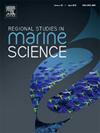基于动态时空数据的马六甲和新加坡海峡超大型集装箱船舶碳排放评估
IF 2.4
4区 环境科学与生态学
Q3 ECOLOGY
引用次数: 0
摘要
马六甲海峡和新加坡海峡是世界上最繁忙的航道之一,碳排放密度最高,对区域和全球都构成了重大的环境挑战。本研究采用自下而上的方法,利用两年的AIS数据和技术参数来评估这些海峡中的超大型集装箱船(ULCV)的碳排放。结果表明:亚欧方向的总排放和运输碳强度(TCI)均高于亚欧方向;新加坡港口水域被确定为主要排放热点,其碳排放密度明显高于其他地区。影响研究区域TCI的关键因素包括平均航速、船舶吃水和在新加坡港的停泊时间。TCI与减速比呈线性关系,船舶吃水的增加降低了TCI,但同时减弱了慢速减排的效果。减少马六甲和新加坡海峡ULCV碳排放的有效策略包括港口停留期间的岸电利用,优化航速同时最小化停泊时间,以及增加欧亚方向的货物负荷。这些发现为减少高密度航运走廊的排放提供了重要见解,为可持续的海上作业提供了宝贵的指导。本文章由计算机程序翻译,如有差异,请以英文原文为准。
Carbon emissions assessment of ultra large container vessel in Malacca and Singapore Straits based on dynamic spatiotemporal data
The Malacca and Singapore Straits, among the world’s busiest shipping lanes, exhibit the highest carbon emission density, posing significant environmental challenges both regionally and globally. This study employs a bottom-up approach, utilizing two years of AIS data and technical parameters to assess the carbon emissions of Ultra Large Container Vessel (ULCV) in these straits.The results indicate that total emissions and transport carbon intensity (TCI) in the Asia-Europe direction are higher than in the Europe-Asia direction. Singapore Port waters are identified as the primary emission hotspot, with a carbon emission density significantly higher than other areas. The key factors influencing TCI in the study area include average sailing speed, vessel draft, and berthing time at Singapore Port. TCI exhibits a linear relationship with speed reduction ratio, while increasing vessel draft reduces TCI but simultaneously weakens the emission reduction effect of slow steaming. Effective strategies for reducing ULCV carbon emissions in the Malacca and Singapore Straits include shore power utilization during port stays, optimizing voyage speed while minimizing berthing duration, and increasing cargo load in the Europe-Asia direction. These findings provide critical insights for mitigating emissions in high-density shipping corridors, offering valuable guidance for sustainable maritime operations.
求助全文
通过发布文献求助,成功后即可免费获取论文全文。
去求助
来源期刊

Regional Studies in Marine Science
Agricultural and Biological Sciences-Ecology, Evolution, Behavior and Systematics
CiteScore
3.90
自引率
4.80%
发文量
336
审稿时长
69 days
期刊介绍:
REGIONAL STUDIES IN MARINE SCIENCE will publish scientifically sound papers on regional aspects of maritime and marine resources in estuaries, coastal zones, continental shelf, the seas and oceans.
 求助内容:
求助内容: 应助结果提醒方式:
应助结果提醒方式:


